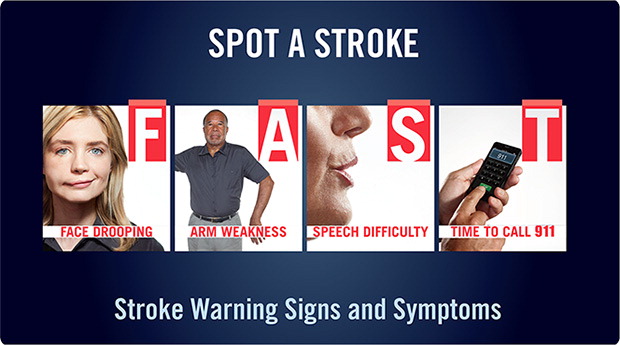Do You Know the Signs of a Stroke?

Stroke is the fifth leading cause of death in the United States. While its ranking has declined in recent years, the American Stroke Association notes that every 40 seconds, someone in the U.S. suffers from a stroke. The organization encourages all Americans to know the signs of a stroke and to take immediate action if any occur.
Signs of a Stroke
There are three types of strokes – ischemic, hemorrhagic, and transient ischemic attack (TIA). The most common – ischemic – is seen in more than 85 percent of stroke victims. During an ischemic stroke, a blockage prevents blood flow to the brain. Hemorrhagic strokes typically occur when an artery bursts in the brain. A TIA, often referred to as a “mini-stroke,” is when an artery is blocked for a shorter period of time. This can be a warning sign that a larger stroke may occur.
Regardless of the type of stroke, it is most important to know when a stroke is happening. The American Stroke Association urges you to watch for these stroke symptoms:
- Sudden numbness or weakness of the face, arm, or leg, especially on one side of the body
- Sudden confusion, difficulty speaking, or understanding speech
- Sudden vision problems in one or both eyes
- Sudden difficulty walking, dizziness, loss of balance, or coordination
- Sudden severe headache with no known cause
Act FAST
Time is not on your side if you suspect you or a loved one is having a stroke. If you or others experience any of the signs above, call 911 within five minutes. It is imperative that you Act FAST!

Courtesy of the American Heart Association
Gender Makes a Difference
While risk factors may vary by age and ethnicity, stroke does not discriminate. Risk factors such as high blood pressure, diabetes, smoking, obesity, and family history are gender neutral. But women have additional risk factors that may be linked to an increased chance of stroke, including pregnancy, taking birth control pills, and being on hormone replacement therapy.
Women can also experience stroke symptoms that men might not. This includes:
- Sudden behavioral change
- Agitation
- Hallucination
- Nausea or vomiting
- Pain
- Seizures
- Hiccups
Prevention is Key
As with other preventable health conditions, such as heart disease, you can cut your risk of having a stroke by taking preventive action. Lifestyle changes, while not always easy, play a major role in reducing your risk. Here are some of the changes you can make, starting today:
Smoking
If you smoke, quit. Smoking can double your risk of having a stroke. There are multiple ways to quit – from pills, patches, and gum, to online, telephonic, and in-person programs. CDPHP® members can access a variety of smoking cessation resources.
Diet and Exercise
Changing your diet to include heart-healthy foods (such as a colorful array of fruits and vegetables) and adding exercise to your daily routine go a long way in helping to reduce your risk. If you are overweight, losing just 5 percent of your body weight can have beneficial effects. CDPHP offers a number of ways to help you control your weight, including free wellness classes and support through its various weight management programs.
Know Your Numbers
High blood pressure is a leading cause of stroke. Talk to your doctor about ways to lower your blood pressure. You should also be aware of other important health numbers, including your cholesterol, blood glucose, and BMI.
Stress
“Keep calm and ….” There’s a reason those memes are so popular these days. Work, family, finances, etc. – stress comes from different sources and is a major part of many people’s lives. Find ways to lower your stress levels, such as meditation, yoga, and breathing techniques.
The American Stroke Association wants you to be a Stroke Hero and make every effort to beat this preventable disease once and for all.

Header photo by Freepik
 The Daily Dose
The Daily Dose
Comments are closed.